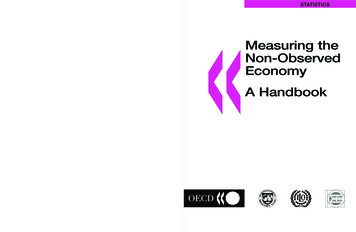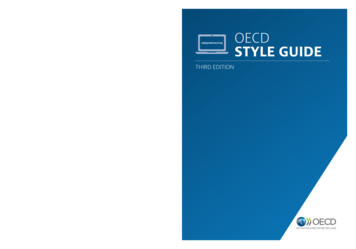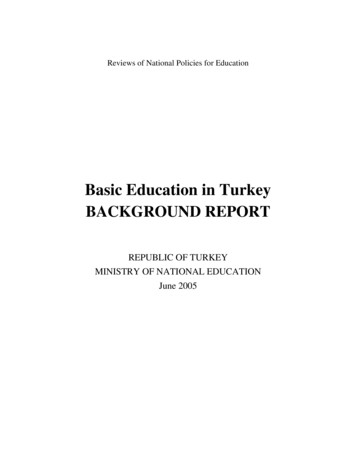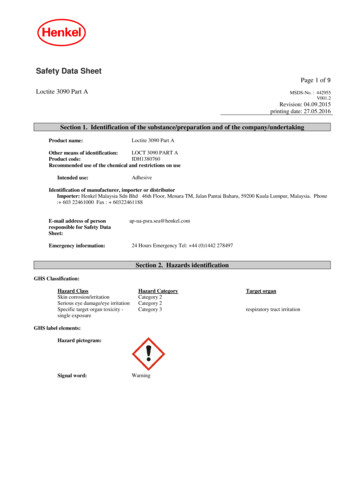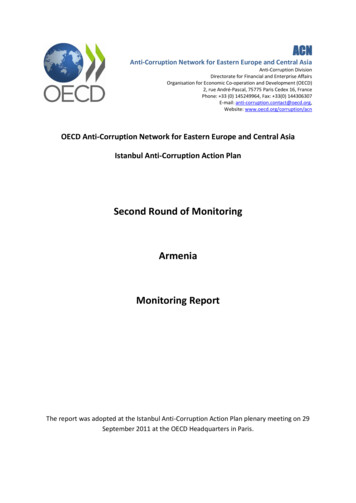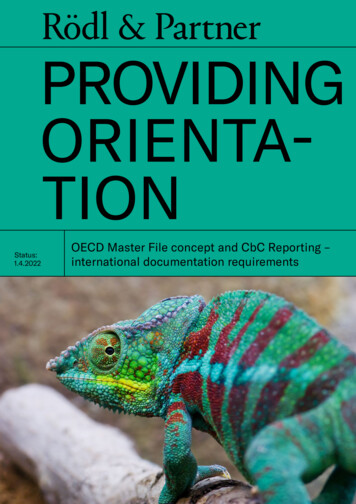
Transcription
Status:1.4.2022OECD Master File concept and CbC Reporting –international documentation requirements
PreambleDear Reader,Due in part to public pressure, the OECD and G20 have adopted a BEPS ActionPlan to address Base Erosion and Profit Shifting (BEPS) by multinational corporategroups. The action plan from 2013 dealt directly with transfer pricing issues in fourpoints. After the final report on Action Item 13 (“Transfer Pricing Documentationand Country-by-Country Reporting“) was published by the OECD in 2015, thethree-tiered documentation approach consisting of Master File, Local File andCountry-by-Country Reporting can now be found in the OECD Transfer PricingGuidelines (last updated in January 2022). Many legislators have in the meantimeimplemented the OECD proposal in full or at least in part into national law.The consequence of the three-tiered approach is that tax administrations gaina much deeper insight into internal group structures. Whether the perception oftransfer pricing as a relevant audit focus or the increasing transparency of transferpricing issues is the reason for increasing transfer pricing adjustments cannotbe conclusively determined in individual cases. Nevertheless, experience showsthat transfer pricing continues to be the focus of tax authorities. Two tendenciessometimes exacerbate the increasing attention to transfer pricing.The considerable impact of the COVID 19 pandemic on the economy suggests thattax administrations want to “save“ their tax revenue precisely by tightening theirscrutiny of international issues, such as transfer pricing.In addition, the introduction of so-called public country-by-country reporting willresult in even greater information and taxation transparency, which will also extendto the public‘s insight into sensitive tax data. The danger of rash judgements ora misguided assessment of the facts can lead to bad publicity that sometimesdisrupts an entire brand perception.In preparation for an upcoming tax audit, the best defence is verifiable transferpricing documentation. Uniform documentation rules help corporate groups toreduce their compliance costs. In addition to the partly persisting formal differencesfor documentation, there are still differences in content in the individual countries,as well as a wide variety of preparation, notification and submission deadlines.Determining the individual tax reporting obligations to which an internationallyoperating group of companies is subject is sometimes laborious and associatedwith uncertainty. However, knowledge of the respective national implementationstatus is an essential compliance task for the transfer pricing management ofinternational groups or companies in order to avoid formal errors and thus an initialtarget with regard to the usability of a documentation.2
With this publication on 62 countries, we would like to provide you with someguidance. Although this does not allow any conclusive statements to be madeabout the individual documentation obligations of your company, we believe thatwe can give you a first helpful overview. If you have any further questions, pleasedo not hesitate to contact our international transfer pricing group at Rödl & Partner.Sincerely yoursMichael Scharf3
ContentsBEPS Action 13 6Service Portfolio 8Your added value 9BEPS Action 13 state of implementationin selected countries 10Country-specific regulations 12Argentina 12Australia 13Austria 14Belarus 15Belgium 16Brazil 17Bulgaria 18Cambodia 19Canada 20China 21Croatia 22Cyprus 23Czech Republic 24Denmark 25Estonia 26Finland 274France 28Georgia 29Germany 30Greece 31Hong Kong (S.A.R.) 32Hungary 33India 34Indonesia 35Ireland 36Israel 37Italy 38Japan 39Kazakhstan 40Kenya 41
Latvia 42Liechtenstein 43Lithuania 44Luxembourg 45Malaysia 46Mexico 47Netherlands 48Nigeria 49Norway 50Philippines 51Poland 52Portugal 53Republic Moldova54Romania 55Russia 56Serbia 57Singapore 58Slovakia 59Slovenia 60South Africa 61South Korea 62Spain 63Sweden 64Switzerland 65Thailand 66Tunisia 67Turkey 68Ukraine 69United Arab Emirates 70United Kingdom 71USA 72Vietnam Country-by-Country-Reporting Notification to the Tax Administration 737474Rödl & Partner 775About us 77Rödl & Partner worldwide 78Contact 79
BEPS Action 13Transfer Pricing Documentation and Countryby-Country ReportingFollowing the points of action developed in the context of the BEPS projectagainst Base Erosion and Profit Shifting of multinational enterprises, countriesimplemented these actions as far as possible via changes in domestic law andpractices and via treaty provisions in order to protect their respective nationaltax bases. The BEPS Action Point 13 (“2015 Final Report – Transfer PricingDocumentation and Country-by-Country Reporting“) provides guidance for TaxAdministrations to improve transparency by developing rules and procedures onsufficient documentation in connection with risk assessment and transfer pricinginquiry. The proposed standardized three-tiered approach to Transfer PricingDocumentation for Multinational Enterprise (MNE) groups has replaced the formerChapter V of the OECD Transfer Pricing Guidelines as of 2017 and should consistof the following: (i) a Master File, (ii) a Local File, and (iii) Country-by-CountryReporting (CbCR).Three-tiered approachMaster h-level riskassessment“)Risk assessmentLocal File(„specific ICtransactions“)Transfer pricinganalysisThe Master File contains standardized information relevant for all MNE groupmembers and should provide a general overview of the MNE group business, placingthe MNE group‘s pricing practices in their global economic, legal, financial andtax contexts. Compared to already existing Master File concepts, the chapters onintangible assets and financing in particular are new. In contrast to the Master Filethe Local File provides more detailed information relating to specific intercompanytransactions for the respective domestic taxpayer to which the Local File applies.The third component of the three-tiered approach is CbC Reportingwhich is generally compiled only by MNE groups with annual consolidated grouprevenue equal to or exceeding EUR 750 million. CbC Reporting requires aggregatetax jurisdiction-wide information related to the global allocation of income, taxespaid, and certain indicators of the location of economic activity among the taxjurisdictions in which the MNE group operates. The Master File and CbC Reportingwill be helpful for risk assessment purposes. However, the Local File comprisesinformation relevant to a detailed transfer pricing analysis for the relevant taxingauthority for each country in which the MNE group is situated.6
DATE?DATE?DATE?LOCAL FILEE.g. with annual taxdeclarationMASTER FILEUpdate (if necessary)analog with Local FileUltimate parentcompanyCbCReportingMaster FileLocal File– Duty of documentation for all FYfollowing 1 January 2016– Usually declaration within twelvemonths after the lastday of theReporting Fiscal Year of the MNEgroupTax AdministrationAutomatic Information exchangeConstituent EntityConstituent EntityConstituent EntityMaster FileMaster FileMaster FileLocal FileTax AdministrationLocal FileTax AdministrationLocal FileThe anticipated flow of information between the members of a MNE group and the taxing authorities.In practice, the ultimate parent company is required to prepare theMaster File and share it with the constituent entities in order to comply with thedocumentation requirements. The ultimate parent company has access to all essentialtax information. Depending on the existing intercompany transactions, the individualcountry specific Local Files can be filed centrally by the ultimate parent company orcan be independently filed by the local companies. The more interlinked and versatilethe intercompany transactions between the individual associated enterprises are, theless the centralization of information filing will be feasible. In general, each ultimateparent company of a MNE group is obligated to file a CbC Report in the country whereit is resident for tax purposes. The OECD concept includes an annual exchange ofinformation received from the reporting entities that is a resident for tax purposesin its jurisdiction with all other competent authorities of jurisdictions with respect towhich it has an agreement in effect, and in which, on the basis of the information inthe CbC Report, one or more constituent entities of the MNE group of the reportingentity are either a resident for tax purposes, or are subject to tax with respect to thebusiness carried out through a permanent establishment.Many countries have already implemented or made initial arrangementsto implement BEPS Action Point 13 in domestic law. An implementation providestax authorities with useful information to assess transfer pricing risks and makedeterminations about where audit resources can most effectively be deployed.Taxpayers are encouraged to articulate convincing, consistent and cogent transferpricing positions in order to be positioned to face what will inevitably be a morethorough risk assessment and audit process by their respective tax authorities.7Tax Administration
Service PortfolioRödl & Partner’s transfer pricing service line supports its international clientsworldwide in the individual structuring, documentation and defence of cross-borderbusiness relationships within the group of companies. We work together, closelyinterlinked across all service lines. We think from a market perspective, where a taxteam possesses all the capabilities to be successful and to realise the client’s goals.Rödl & Partner has many years of experience in supporting multinational enterprisegroups in the area of transfer pricing. Together with our colleagues in over 50countries, we can advise you in the following areas, also based on cross-bordercollaboration, if required:Health CheckDigitalSolutions– IC Maturity Check– OptimisationpotentialDocumentationCbCR– Master File– Data generation– Transaction matrix– Local Files– Data preparation– Segmentation– Global– Report generation– Tax risk assessment– TP Controlling– System design– Simulation– Digital Realisation– Interface design– ERP-Integration– Management of– BI / AnalyticscoordinationDue Dates– Conversion to XMLformat– Transfer– CbCR risk analysis– Digital agendaArm‘s lengthcomparison– Selection of the typeOperational TPDefence TPLegal TP– SWOT analysis– Tax audit– Procedural lawand scope of arm‘s– Process recording– Joint Audit– Duties to cooperatelength transactions– Roadmap to– Mutual agreement– Reporting– Benchmarking– Rating– Valuation– Adjustmentcalculationsexcellence– Best PracticeWorkshops– Coachingprocedurerequirements– APA– Burden of proof– Objection– Usabilityprocedure– Lawsuit– Access rightsconcerning taxaudit– Data protection8
Your added valueRödl & Partner offers you an approach thatcan be briefly summarised as follows:––––“One Face To The Client” approach – you have ONE contact personProfessional assistance for German companies with foreign engagementsCentral project management: Our structure – international, interdisciplinarySpecialists with local expertise – no ‘fly-in’ consultantsThus, Rödl & Partner offers you the followingadded value:––––Your consultant speaks your language anywhere in the world – also in a figurative senseRegular advice offered by a team of consultants and a direct point of contact One-stop-shop concept – coordination of service providers that saves you timeImmediate and direct access to the best local experts, without language and timebarriers– You get an easy, consistent, cost-efficient and transparent overview of your projectsworldwide– You receive directly usable information firsthand– We offer you international hands-on solutionsONEFIRM9ONETEAM
BEPS Action 13 stateof implementation inselected daChinaGeorgiaHong Kong laysiaMexicoNigeriaPhilippinesRussiaSingaporeSouth AfricaSouth KoreaThailandTunisiaUnited Arab EmiratesUSAVietnamImplementedPartially implementedImplementation expectedNo implementation10
BEPS Action 13 stateof implementation inselected aCyprusCzech bourgNetherlandsNorwayPolandPortugalRepublic tzerlandTurkeyUkraineUnited KingdomImplementedPartially implementedImplementation expectedNo implementation11
Country-specific regulationsARGENTINAMaster FileLocal FileCbCR–––––––The Master File has beenimplemented for FYs startingfrom 1 January 2018.Thresholds:– The taxpayer is a member of aMNE Group with consolidatedrevenues higher than ARS 4billion in the previous fiscal year;and– The transactions carried out withforeign related parties exceedARS 3 million (jointly) or ARS300,000 (individually).Submission deadline: Between the23rd and the 27th day of the twelfthmonth following the end of the fiscalyear.Language: Spanish only.Penalties: Up to ARS 45,000 fornon-compliance with the submissiondeadline.––––––In Argentina, a Local File (called TPReport or Study) has been in placesince the fiscal year 1999.Although it is not completely inline with BEPS 13, it contains – to acertain extent – similar information.Thresholds: Transactions withforeign related parties and / ortransactions with counterpartieslocated in non cooperativejurisdictions or in low or niltax jurisdictions exceed ARS 3million (jointly) or ARS 300,000(individually).Submission deadline: Between the23rd and the 27th day of the sixthmonth following the end of the fiscalyear.Duty of notification: Not applicable.Also, an informative statement oftransactions must be filed, when thefollowing thresholds are met:– Transactions with foreign relatedparties and / or transactionswith counterparties located innon-cooperative jurisdictionsor in low or nil-tax jurisdictionsexceed ARS 3 million (jointly) orARS 300,000 (individually); or– Exports and imports withindependent parties exceedARS 10 million (jointly).Penalties:– Non-submission of informationregarding transactions withforeign related parties willresult in a fine of ARS 10,000(ARS 20,000 for foreign-ownedtaxpayers).– Non-submission of informationregarding exports and importswith independent parties willresult in a fine of ARS 1,500(ARS 9,000 for �Legally effective for fiscal years as from1 January 201812Legally effective for fiscal years as from1 January 1999The CbCR according to BEPSAction 13 has been implementedfor FYs starting from 2017.Threshold: Consolidated revenueof at least EUR 750 million in theprevious year.Preparation and submissiondeadline: Submission withintwelve months after the endof the fiscal year.Language: SpanishSurrogate filing: Has beenimplementedSecondary filing: Has beenimplementedDuty of notification: Withinthree months after the end ofthe fiscal year on the website ofthe Argentinian tax authority. Inaddition, a secondary notificationmust be filed within two monthsof the CbCR submission deadline,which must contain a specificdate of submission by a foreignentity.Penalties:– A fine ranging between ARS80,000 and ARS 200,000 forfailure to notify;– In the case of failure tosubmit, the fine rangesbetween ARS 600,000and ARS 900,000.– In addition, taxpayers will besubject to further sanctions:– Increased risk of taxaudits in the future;– Suspension or exclusionfrom specific tax registers;and– Suspension from theapplications to obtainexemption from thewithholding tax.Argentina is a signatory ofMultilateral Competent AuthorityAgreement on the Exchange ofCbCR (the “CbC MCAA”).A TXT format similar to theOECD‘s XML format has beenimplemented.Legally effective for fiscal years asfrom 1 January 2017
Country-specific regulationsAUSTRALIAMaster FileLocal FileCbCR––––––The Master File concept accordingto BEPS Action 13 has beenincorporated into the domesticlegislation.A CbC Reporting Entity is requiredto provide the Australian TaxationOffice (ATO) with an English versionof the Master File prepared by theglobal CbC Reporting Parent.Master File must be submittedelectronically as an attachment tothe Local File.Exemptions are possible in limitedcases only (e.g. for the first year ifthe foreign parent is in a jurisdictionwhich has not yet adopted theMaster File concept). Exemptionsmust be applied for and are notautomatic.––Local File must be lodged by CbCReporting Entities in a prescribedelectronic format which is unique toAustralia. There is a “short form” forcompanies which are characterisedas small in Australia and havecertain attributes.Local File requirements are separateto the local Transfer PricingDocumentation requirements inAustralia which apply to all entitiesin general, although there is aSimplified Transfer Pricing RecordKeeping Option available for specificsmall local entities.Also, there is a requirement for CbCReporting Entities to lodge GeneralPurpose Financial Statements(GPFS) with the ATO at the time oflodging the annual company taxreturn unless they have already beenlodged with the corporate regulator.––––––The CbCR according to BEPSAction 13 has been implementedfor FYs starting from 2016.Language: Only in EnglishSurrogate filing: Has beenimplementedSecondary filing: Has beenimplementedDuty of notification: An entity isrequired to file a notification ofits SGE and CbC Reporting Entitystatus in the annual company taxreturn (as a rule, 6.5 months afterthe year-end).Australia is a signatory of theMultilateral Competent AuthorityAgreement on the Exchange ofCbCR (the “CbC MCAA”).OECD‘s XML format forsubmission has beenimplemented.Requirements / thresholds:– For income years commencing on or after 1 July 2019, Australian tax laws have changed to define a “CbC Reporting Entity” asa member of a consolidated group of entities tracing back to a CbC Reporting Parent which generated annual global incomeexceeding AUD 1 billon in the previous year.– The concept of a “Significant Global Entity” (SGE) has been extended to include groups headed by individuals or otherwisewhere no formal accounting consolidation is required. The SGE status involves additional integrity rules and the followingheightened penalties:– Failure to file on time results in penalties of up to AUD 555,000 per filing obligation.– False or misleading statements can be fined at up to 150 % of the tax shortfall, or, if there is no shortfall, with a penaltyof AUD 26,640. The penalty may be reduced if reasonable argumentation is presented. A penalty reduction arising outof transfer pricing adjustments may be applied if local Transfer Pricing Documentation requirements are met before theannual tax return is filed.– Preparation and submission deadline: Within twelve months after the end of the fiscal year– Special regulation due to COVID-19 pandemic: A COVID-19 extension was granted until 4 February 2022 for fiscal years endedin December 2020)Legally effective for fiscal years commencing on or after 1 January 201613
Country-specific regulationsAUSTRIAMaster File–––––––Local FileThe Master File concept according to BEPS Action 13 has been incorporated intothe domestic legislation.Requirements / thresholds:– An Austrian entity is part of a MNE group; and– The Austrian entity’s revenue exceeded the amount of EUR 50 million in eachof the two preceding years.– The obligation ceases to apply if the threshold is not met for two precedingyears.– If the thresholds are not exceeded in Austria, the tax authorities may requestthe submission of a Master File if a Master File has been prepared by anothergroup entity.Duty of notification and deadline for the preparation: No fixed deadline. Thetax authorities may request submission of the Master File and the Local Filefollowing the submission of the tax return. However, since 2021, the AustrianTransfer Pricing Guidelines stipulate that the documentation must be preparedat the latest at the time of filing the local tax return for the year in question.Submission deadline: Upon request, within 30 days.Language: German or English.Penalties: Up to EUR 5,000 for non-complianceAlso if the revenue is below the threshold, the Transfer Pricing Documentationmust be prepared based on the general recording and cooperation obligations ofthe taxpayer (§§ 124, 131 and 138 BAO).CbCR––––––––––Legally effective for fiscal years as from 1 January 201614The CbCR according to BEPSAction 13 has been implementedfor FYs starting from 2016.Threshold: Annual consolidatedgroup revenue of at least EUR 750million in the previous year.Preparation and submissiondeadline: No later than twelvemonths after the end of the fiscalyear.Language: EnglishSurrogate filing: Has beenimplementedSecondary filing: Has beenimplementedDuty of notification: By the endof the fiscal year (form VPDG1, per mail or electronically viaFinanzOnline). For FY startingfrom 1st January 2022 onwards,a CbC notification only must besend, when changes occurred.Penalties: Up to EUR 50,000.Austria is a signatory of theMultilateral Competent AuthorityAgreement on the Exchange ofCbCR (the “CbC MCAA”).OECD‘s XML format forsubmission has beenimplemented.
Country-specific regulationsBELARUSMaster File–––15Local FileThe Master File concept according to BEPS Action 13 does not contravene thelocal legislation and is largely accepted, however it has not been incorporatedinto national law.Local documentation requirements:– A documentation requirement applies to “large” taxpayers (revenue exceedsEUR 75 million) with the transaction volume of more than BYN 2 million(about EUR 650,000) per year; or– Other taxpayers who are involved in transactions with ”strategic“ goods(e.g. crude oil and oil products, natural gas, potassium, raw wood, steel)in the same volume (EUR 650,000 per year). The documentation must beprepared after the end of the fiscal year and submitted upon request. It maybe requested by the tax authorities at any time starting from 1 June of thefollowing year.– In the following cases a short version of the documentation (“shortdocumentation”) must be submitted upon request (early preparation is notrequired):– Acquisition or sale of goods or services by or to an offshore entity, or anaffiliated foreign-based entity, or an affiliated entity which is CIT taxexempt in Belarus, with the transaction volume exceeding BYN 400,000(approximately EUR 125,000) within a calendar year; or– Real estate transactions with an affiliated entity or natural person(regardless of the transaction volume). The short documentation should beprovided upon request within the time limit specified by the tax authority(as a rule – ten working days).– Penalties: No sanctions are imposed for the missing documentation, but thetax authority may, on the basis of its own calculation, request the additionalpayment of corporate income tax.Requirements as to the content and form of the documentation / Shortdocumentation:– The documentation / short documentation must be prepared in accordancewith the statutory template, but the submission of any additional informationis explicitly permitted.– The announced comprehensive template for documentation / shortdocumentation is a one-tier document (no differentiation between Master Fileand Local File, no CbCR).– Language: RussianCbCR––The CbCR according toBEPS Action 13 has not beenimplemented yet.It is expected that theimplementation of CbCR inRussia and improving IT affinityof the Belarusian tax authoritieswill accelerate the process inBelarus.
Country-specific regulationsBELGIUMMaster FileLocal FileCbCR–––––––––The Master File concept accordingto BEPS Action 13 has beenincorporated into the domesticlegislation.Requirements / thresholds: A MasterFile must be filed if the Belgianconstituent entity exceeds one ofthe following criteria for the fiscalyear immediately preceding the mostrecently closed fiscal year:– Total operating and financialrevenue of more than EUR 50million per Belgian constituententity (excl. non-recurringrevenue); or– Balance sheet total of morethan EUR 1 billion per Belgianconstituent entity; or– Annual average of more than 100full-time equivalents (employees)per Belgian constituent entity.Preparation and submissiondeadline: Within twelve months ofthe end of the fiscal year of the MNEgroup.Language: English, French, Dutch,GermanPenalties: Non-compliance with thesubmission deadline can result ina fine ranging between EUR 1,250and EUR 25,000 as from the secondviolation in the event that theviolation was not committed in badfaith. If the violation was committedin bad faith, the fine amounts toEUR 12,500 for the first violationand EUR 25,000 as from the secondviolation.XML format for submission has beenimplemented.Note: If an MNE group has multipleBelgian constituent entities, eachBelgian constituent entity thatmust file a Master File is obligedto file the exact same Master File.The law does not permit for asingle submission by one Belgianconstituent entity covering theobligation of all Belgian constituententities.Legally effective for fiscal years as from1 January 201616–––––Requirements / thresholds: The samerequirements as in the case of theMaster File.Submission deadline: The LocalFile must be filed by the samesubmission deadline as theCorporate Income Tax Return of theBelgian constituent entity relatingto the fiscal year. (Please note: TheCorporate Income Tax Return andthe Local File cannot be filed viathe same portal - the CorporateIncome Tax Return must be filedvia BizTax and the Local File – viaMyMinFinPro).Language: English, French, Dutch,GermanPenalties: Non-compliance with thesubmission deadline can result ina fine ranging between EUR 1,250and EUR 25,000 as from the secondviolation in the event that theviolation was not committed in badfaith. If the violation was committedin bad faith, the fine amounts toEUR 12,500 for the first violationand EUR 25,000 as from the secondviolation.The Local File consists of 3 parts: A,B and C. Part A must always be filedif the Local File is required. Part Bmust be filed only if at least one ofthe business units of the Belgianentity has executed cross-borderintra-group transactions of morethan EUR 1 million. In such a casePart B must be completed for eachbusiness unit that has exceededthis threshold. It is permitted, whencompleting the detailed informationper business unit (Part B) in thetables B3 to B6, to take into accounta materiality requirement of EUR25,000 per transaction. The samemethodology (with or withoutmateriality requirement) must beapplied to all business units. Part Cis optional and can be used for filingappendices.XML-Format for submission hasbeen implemented.Part A & C are legally effective for fiscalyears as from 1 January 2016; Part B asfrom 1 January 2017–––––––––The CbCR according to BEPSAction 13 has been implementedfor FYs starting from 2016.Threshold: A MNE group mustfile the CbCR if it has generatedconsolidated revenue of EUR750 million as shown in theconsolidated financial statementsof the group for the fiscal yearimmediately preceding the mostrecently closed fiscal year.Submission deadline: Withintwelve months of the end of thefiscal year of the MNE group.Language: English, French,Dutch, GermanSurrogate filing: Has beenimplementedSecondary filing: Has beenimplementedDuty of notification: Thenotification form must be filed bythe end of the fiscal year of theMNE group. As of the fiscal yearending on 31 December 2019 orlater, only changes have to benotified.Penalties: Non-compliance withthe submission deadline canresult in a fine ranging betweenEUR 1,250 and EUR 25,000 asfrom the second violation in theevent that the violation was notcommitted in bad faith. If theviolation was committed in badfaith, the fine amounts to EUR12,500 for the first violation andEUR 25,000 as from the secondviolation.Belgium is a signatory of theMultilateral Competent AuthorityAgreement on the Exchange ofCbCR (the “CbC MCAA”).OECD‘s XML format forsubmission has beenimplemented.Legally effective for fiscal years asfrom 1 January 2016
Country-specific regulationsBRAZILMaster File––Local FileThe Master File concept according to BEPS Action 13 has not been implemented yet.Local documentation requirements:– Obligation to prepare documentation: Pursuant to the Law No. 9.430 / 96and the Normative Instruction #1312 / 2012, intercompany transactions (e.g.supply of goods, provision of services, transfer of rights or loans) are subjectto domestic transfer pricing rules. Brazilian companies electing the PresumedProfit Method to assess their corporate income tax are exempt from theobligation to perform the calculation of import transactions.– Submission deadlines: The full documentation does not need to besubmitted, but the calculation must be prepared until the last business day ofJanuary of the following calendar year (in connection to the Corporate IncomeTax Payment term); Special forms within the Corporate Income Tax Returnmust be filed until the last business day of July of the following calendaryear (the documentation must be kept on file for five years). The calculationshould be performed on a yearly basis to assess whether any adjustment tothe corporate income tax base should be made on an item-by-item basis,irrespective of the value of intercompany transactions. Safe harbour appliesonly to export transactions, provided that specific criteria are met.– Duty of notification: Yearly obligation. No notification obligation regardingpreparation of documentation; Calculated fiscal adjustments must bedisclosed in the Corporate Income Tax Return for the following year (lastbusiness day of July).– English documentation is not accepted.– Penalties for non-compliance: Non-deductibility of expenses, if applicable,adjustment of the corporate in
Reporting“) was published by the OECD in 2015, the three-tiered documentation approach consisting of Master File, Local File and Country-by-Country Reporting can now be fo

